Why you can trust Tom's Hardware
The FO48U’s Green picture mode is a true set and forget option. And it’s the default mode, which makes things that much easier. Just set brightness to taste, and you’re ready to rock.
Grayscale and Gamma Tracking
Our grayscale and gamma tests use Calman calibration software from Portrait Displays. We describe our grayscale and gamma tests in detail here.
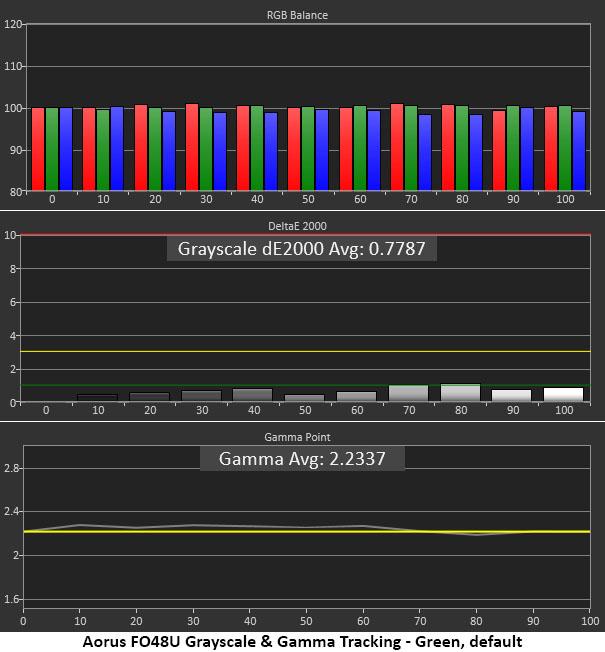
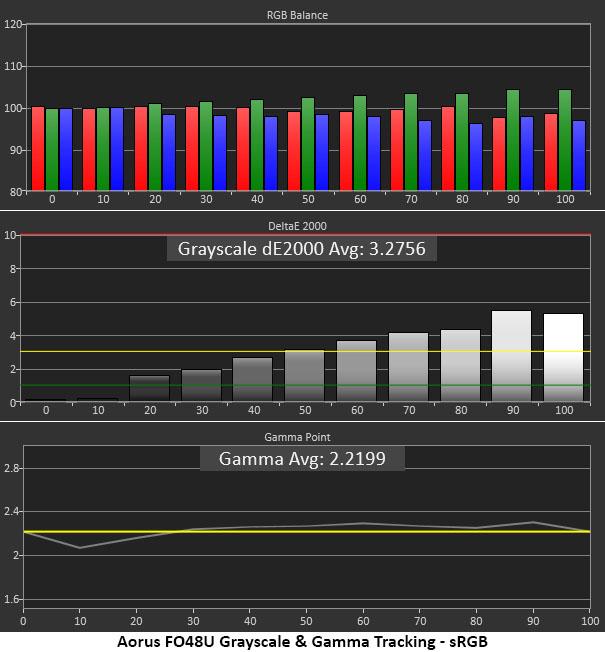
The FO48U measures incredibly well out of the box. Grayscale tracking shows no visible errors with every value under 1 Delta E (errors are generally considered invisible to the naked eye if they’re under 3dE). Gamma, meanwhile, tracks the 2.2 line almost perfectly. If you’re measuring your own FO48U, or any OLED, make sure to use 25% window patterns. This overcomes the variable brightness inherent to all self-illuminating technologies.
In the sRGB picture mode, we saw some green errors in steps above 50% brightness. Gamma tracks reasonably well, but the green tint is visible in content. We consider this mode usable but just barely. After a few back-and-forth comparisons in-game, we stuck with the Green mode.
Comparisons
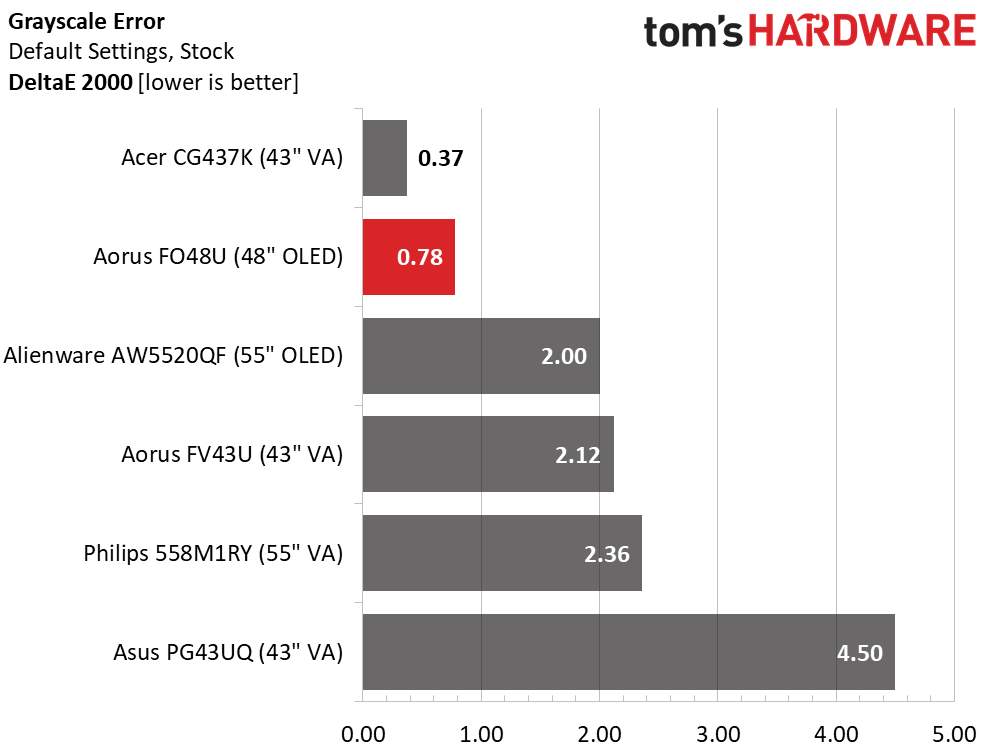
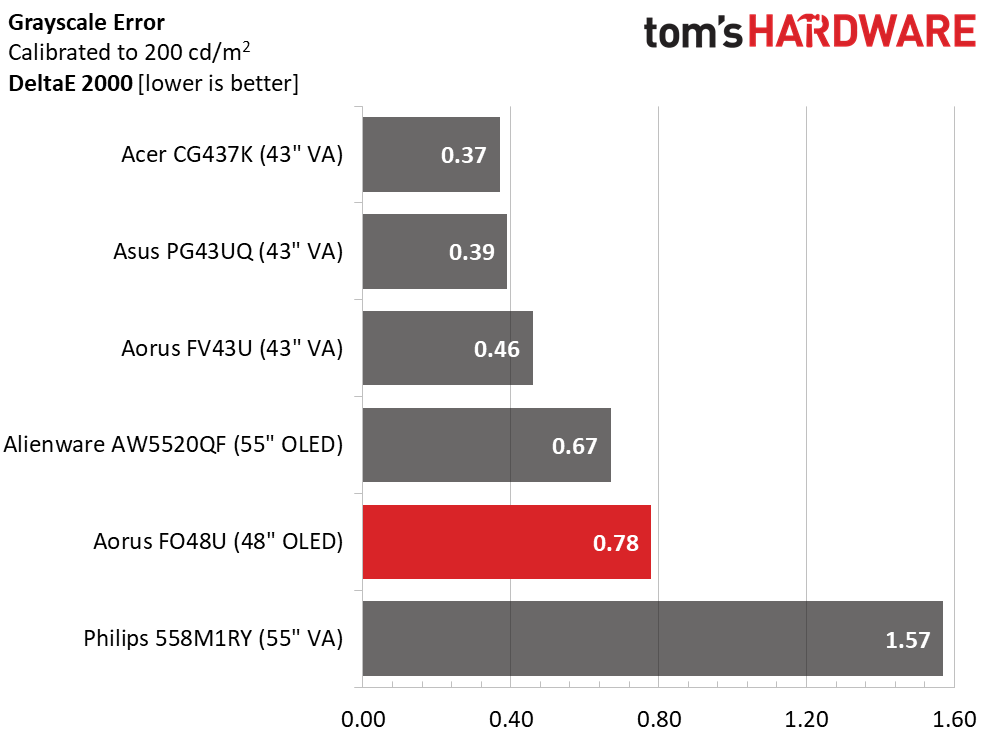
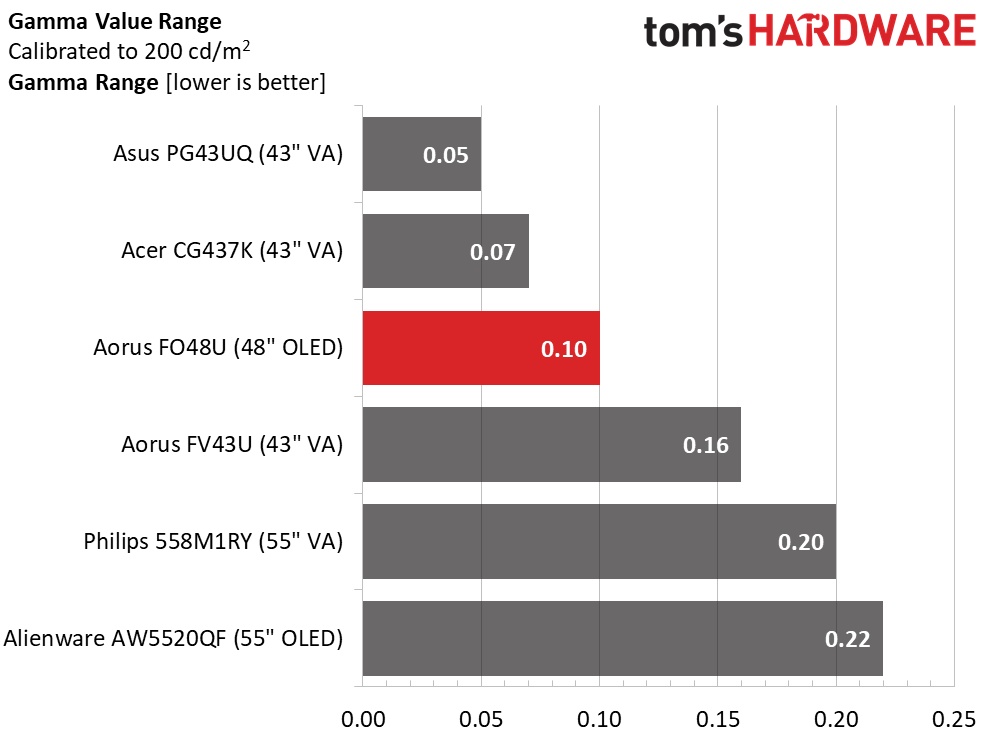
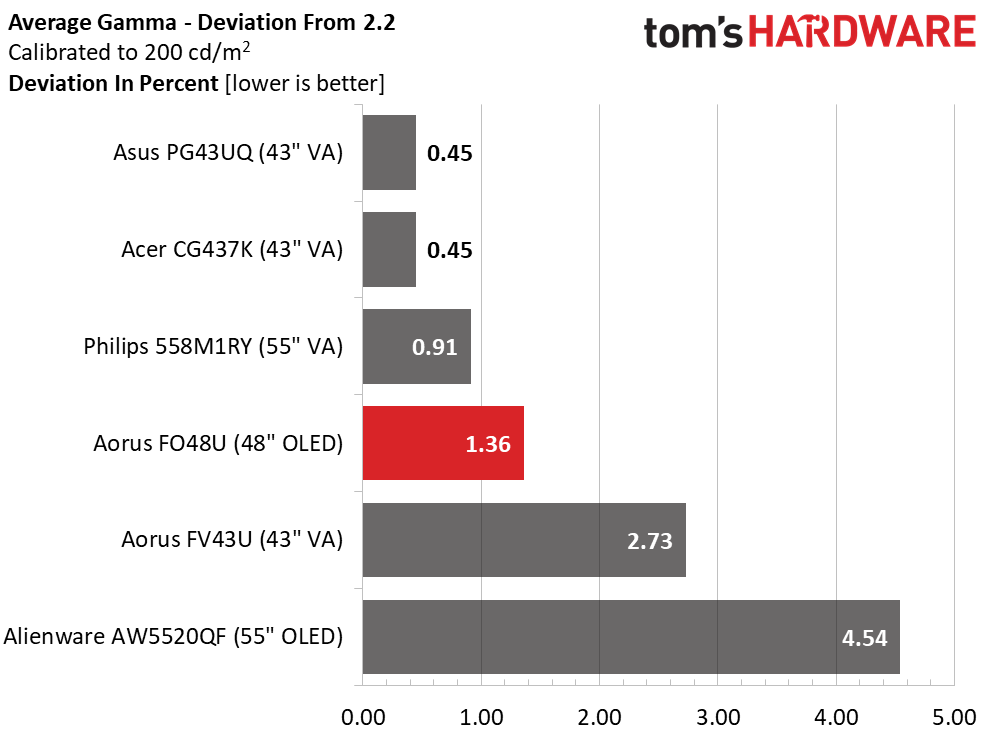
The FO48U delivers professional-level accuracy without calibration, and so does the Acer CG437K. After all the monitors are calibrated, the Aorus is in fifth place, thanks to the group’s very high quality. Any score less than 1dE in this test should be considered reference-level.
The gamma results are similar. Though the FO48U is mid-pack, it’s only because the entire field is so good. All of the monitors in the group show excellent performance here.
Color Gamut Accuracy
Our color gamut and volume testing use Portrait Displays’ Calman software. For details on our color gamut testing and volume calculations, click here.
Get Tom's Hardware's best news and in-depth reviews, straight to your inbox.
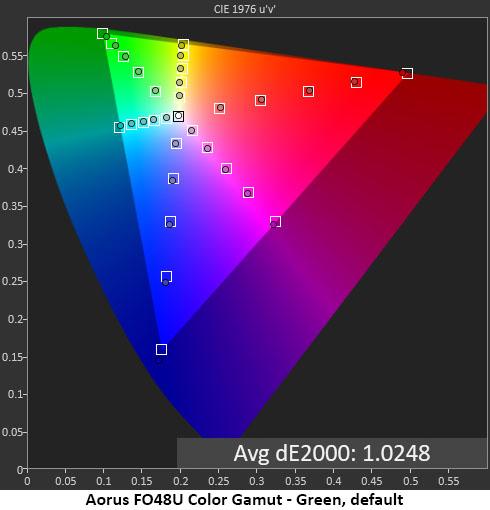
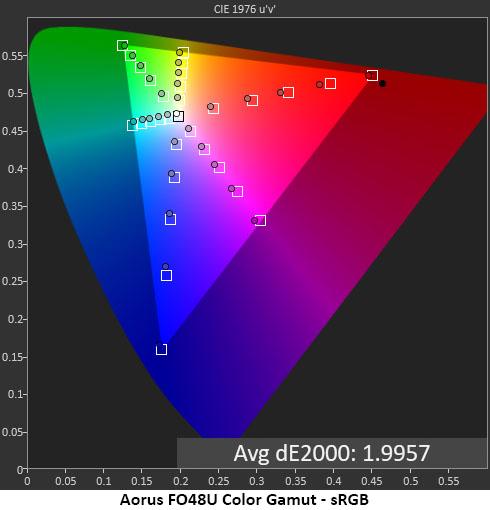
The FO48U’s default color gamut chart is nothing short of impressive. Every measurement is on its target. Blue shows a tiny bit of oversaturation at the triangle perimeter, but this wasn’t visible in actual content. Again, we’re seeing reference-level accuracy here.
The sRGB mode is very good as well with just a little undersaturation in red, magenta and blue, but these errors do not affect real-world content. If not for the greenish grayscale tracking, sRGB would be reference-level too. The mode is usable, but we ultimately preferred to stick with the FO48U’s full native gamut for both SDR and HDR content.
Comparisons

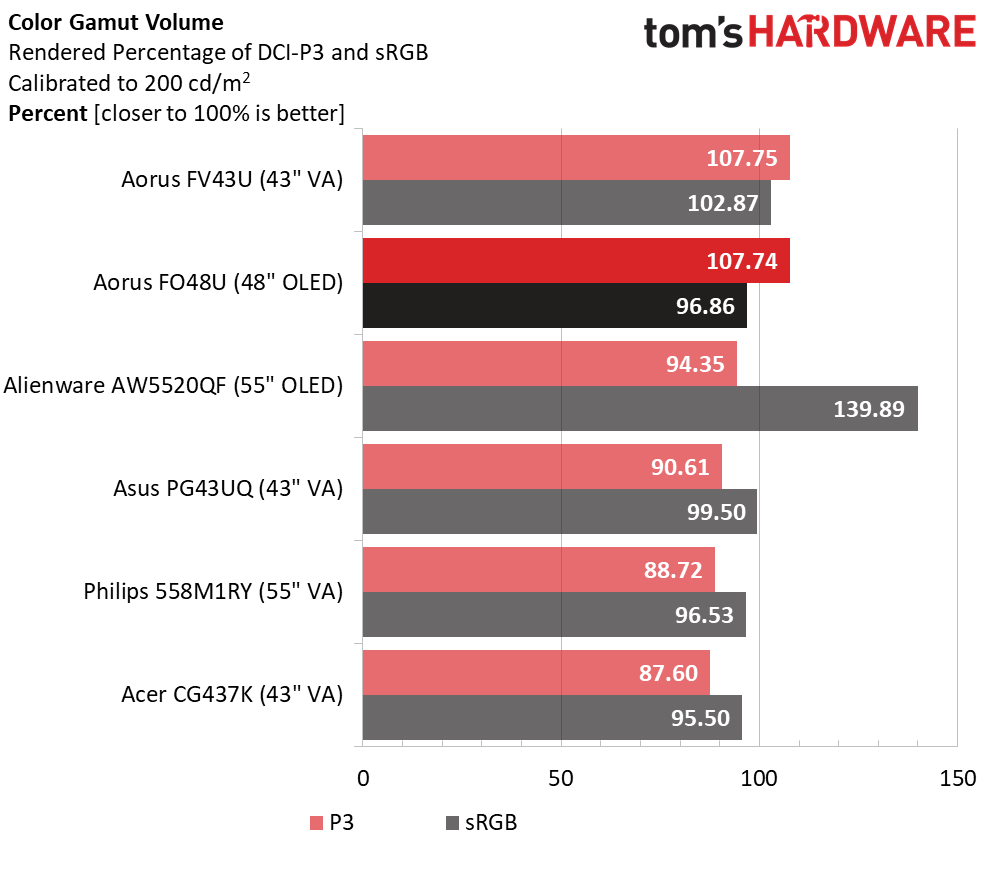
Only a handful of monitors in our database can match color accuracy with the FO48U. That 1.02dE result is an average of 31 measurements, so this achievement is no small feat. The other screens, particularly the VA panels, also perform well here. The Aorus has certainly pipped its chief competitor, the AW5520QF.
Though the Alienware impressed us at the time with its 94.35% coverage of DCI-P3, the FO48U beats that score significantly. A little bonus blue coupled with full coverage of the other primary colors returns one of the best gamut volume scores we’ve yet recorded: 107.74%. We can’t help but notice it’s almost identical to the coverage of the FV43U, which is a completely different monitor and technology. If you’re looking for an OLED panel for your photo or video editing hardware suite, the FO48U more than qualifies and is far cheaper than a professional monitor.
Current page: Grayscale, Gamma and Color
Prev Page Brightness and Contrast Next Page HDR Performance
Christian Eberle is a Contributing Editor for Tom's Hardware US. He's a veteran reviewer of A/V equipment, specializing in monitors. Christian began his obsession with tech when he built his first PC in 1991, a 286 running DOS 3.0 at a blazing 12MHz. In 2006, he undertook training from the Imaging Science Foundation in video calibration and testing and thus started a passion for precise imaging that persists to this day. He is also a professional musician with a degree from the New England Conservatory as a classical bassoonist which he used to good effect as a performer with the West Point Army Band from 1987 to 2013. He enjoys watching movies and listening to high-end audio in his custom-built home theater and can be seen riding trails near his home on a race-ready ICE VTX recumbent trike. Christian enjoys the endless summer in Florida where he lives with his wife and Chihuahua and plays with orchestras around the state.
-
mihen Already able to see some very minor burn in after playing a game for 10 hours that has a fixed UI. Only visible on dark gray screens. I was at 100% brightness =/, went down to 30% as suggested by others.Reply -
saunupe1911 Why would I even consider this over a 48 inch LG C1 at $1299....$1596 with 2 year burn protection?Reply -
deesider For people who use this size of monitor (or TV), how far away do you sit from it?Reply
I just can't imagine sitting at a desk with a 48" screen. I use a 27" as my main and prefer to sit at least 1 metre away. -
Bryman Reply
I sit about 38 to 44" away on my LG c1 when using for gaming/pc and 48" when watching TVdeesider said:For people who use this size of monitor (or TV), how far away do you sit from it?
I just can't imagine sitting at a desk with a 48" screen. I use a 27" as my main and prefer to sit at least 1 metre away.
Desk is 33" deep -
larsv8 Replydeesider said:For people who use this size of monitor (or TV), how far away do you sit from it?
I just can't imagine sitting at a desk with a 48" screen. I use a 27" as my main and prefer to sit at least 1 metre away.
If you check my sig to the pcpartpicker build I had a custom desk built to place my 48 incher further away.
It sits about 42 inches away, but its wall mounted so a little bit closer. -
Spike_xps720 Reply
I have Acer Predator CG437K 43" monitor and I am sitting 33" from it. I love this monitor. All 4K details are bigger and gaming experience is great.deesider said:For people who use this size of monitor (or TV), how far away do you sit from it?
I just can't imagine sitting at a desk with a 48" screen. I use a 27" as my main and prefer to sit at least 1 metre away. -
rdmetz Reply
That's just image retention no oled is going to burn in after 10 hours. It will go away with varied content.mihen said:Already able to see some very minor burn in after playing a game for 10 hours that has a fixed UI. Only visible on dark gray screens. I was at 100% brightness =/, went down to 30% as suggested by others.
I've gamed for 1000's of hours (some at 100% for hdr the rest at 80%) on my 2019 lg c9 and have zero signs of permanent burn in.
Almost all panels that exist today are just LG display panels and for the most part should have similar burn in protections.
If you're talking about a panel pre 2018 then yes burn in was a bit more likely and even I, with the same game I've put thousands of hours in on my 2019 c9, saw permanent burn in on my 2016 after just 3 months and maybe 300 hours of said game.
Today its very very difficult to burn in your screen unless your absolutely careless or are purposefully disabling protections built in and enabled by default. -
rdmetz Replydeesider said:For people who use this size of monitor (or TV), how far away do you sit from it?
I just can't imagine sitting at a desk with a 48" screen. I use a 27" as my main and prefer to sit at least 1 metre away.
I game on a 65" C9 OLED and while I have a desk and keyboard mouse setup about 24" in front of it (it's wall mounted) but I do most of my gaming about 4 feet from it using a controller.
My vision isn't great and honestly only with a large screen and pretty much "immersed" can I actually stay competitive in the fps type games I like to play. Seeing "deep" into the picture is hard for me unless my vision is pretty much dominated by screen. I've grown quite accustomed to it and just make sure any hud elements are pulled in as close to center as possible so I don't have to move my eyes too much. -
Friesiansam Reply
It is an exaggeration. To be infinitely black it would have to be invisible, emitting or reflecting absolutely no light whatsoever. Even Vanta Black still reflects a very tiny amount of light.[URL='https://www.tomshardware.com/uk/author/christian-eberle']Christian Eberle[/URL] said:
This is thanks to its ability to shut off individual pixels on the fly to create an infinitely low black level. The word infinitely is not an exaggeration. -
mihen Replyrdmetz said:That's just image retention no oled is going to burn in after 10 hours. It will go away with varied content.
I've gamed for 1000's of hours (some at 100% for hdr the rest at 80%) on my 2019 lg c9 and have zero signs of permanent burn in.
Almost all panels that exist today are just LG display panels and for the most part should have similar burn in protections.
If you're talking about a panel pre 2018 then yes burn in was a bit more likely and even I, with the same game I've put thousands of hours in on my 2019 c9, saw permanent burn in on my 2016 after just 3 months and maybe 300 hours of said game.
Today its very very difficult to burn in your screen unless your absolutely careless or are purposefully disabling protections built in and enabled by default.
Thanks, I was worried when I noticed it.